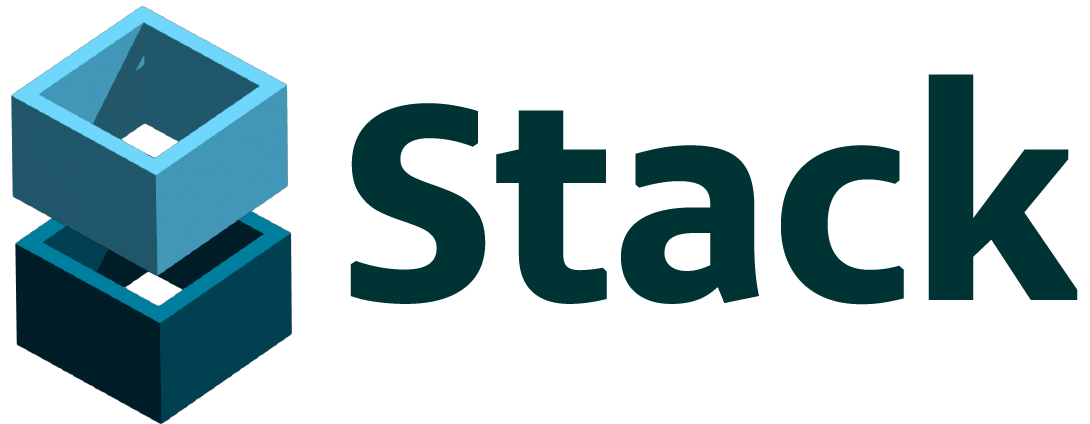Our view at Stack - ClickFunnels was founded by an online marketing legend Russell Brunson and it offers several benefits for online businesses and marketers:
- Time and Cost Savings: Efficiently create sales funnels without extensive development efforts.
- Maximized Conversions: Test offers, copy, and images to enhance conversions.
- Specific Landing Pages: Generate highly targeted landing pages.
- Predictable Pipeline: Create consistent, predictable sales paths.
- Increased Sales: On average, it boosts sales of lesser products by 15%
The post 7 Small Business Marketing Ideas appeared first on ClickFunnels.
Whether you’ve already started your small business — or you’re looking at starting one — I can tell you that developing a strong online presence is absolutely critical.
Today, it doesn’t matter what business you’re in, nearly every single one of your customers will be looking for businesses like yours online.
To help you develop that online presence, we’ve put together 7 small business marketing ideas that have been proven to generate attention and convert that attention into new customers.
If you’re a new small business owner, or you’re thinking about starting one, have no fear.
We’re here to help you create a strategy that will boost your online presence without making you feel overwhelmed and stressed out.
By the time you’re done reading this guide, you’ll have a clear-cut plan for marketing your small business.
And that plan starts with…
Email Marketing
Picture this.
You’re hosting an upcoming event. Or launching a new product. Or running a special discount.
What’s the easiest way to let ALL of your customers know about it?
Simply send them an email notifying them.
When it comes to small business marketing ideas, email marketing is one of the ONLY ways you can maintain a direct line of contact with ALL of your customers at the same time.
Social media can’t do that because the algorithms pick and choose who sees what and when.
Search engines only work when someone is actively searching for your business.
That means you’ll want to start building your email list and using email marketing immediately.
When you do, you can contact them with WHATEVER you want, knowing (when you’ve set it up properly) that you’ll hit their inbox and bring them back to your business.
To get started, there are a few things you’ll need to do.
The first is having a physical signup sheet at the counter in your business where walk-ins can provide their email addresses.
In order to entice them to give you their email, you may need to incentivize their subscription with a one-time discount code or another type of attractive perk.
Then, it’s time to take it online.
As you’re building your list, you’ll want to notify people on social media what they’ll get if they subscribe.
For instance, Ramit Sethi invited people to join his newsletter:

You can also take advantage of your bio on your social media profiles:
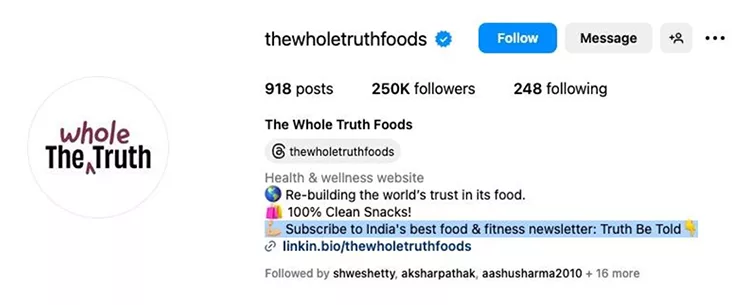
After you start taking advantage of social media, you’re going to need somewhere for your visitors to go where they can give you their email address.
That’s where a landing page comes in.
A landing page, if you’re unfamiliar, is a page on your website with an email subscription form where you can collect emails — and incentivize people with a special bonus.
For instance, here’s how Alex Cattoni does it:
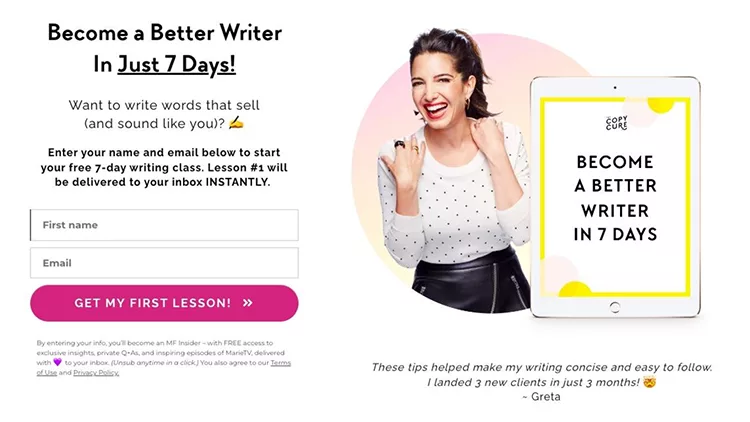
Here’s another great example of a landing page with an email subscription form:
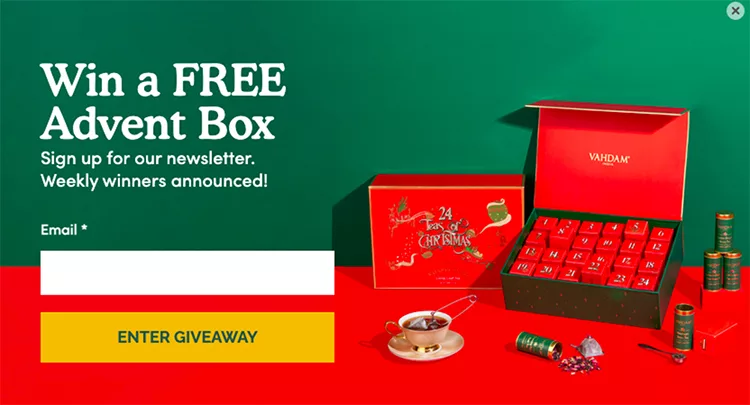
The second part of this strategy revolves around sending emails to your list.
There are quite a few different emails you can send, too.
Like notifying them of an upcoming product launch:

Or notifying them of new sales and promotions:
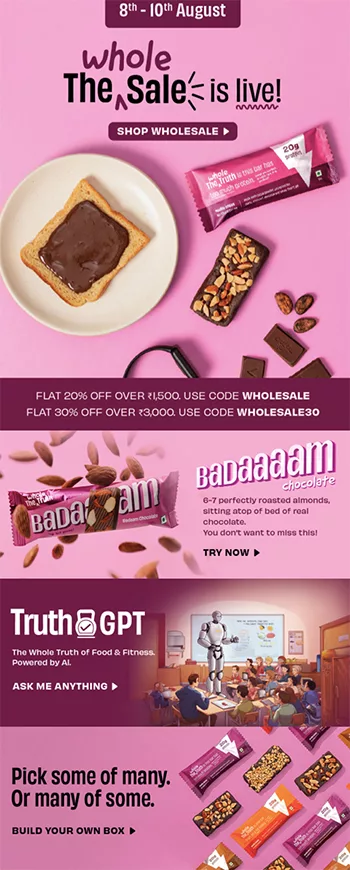
Staying in touch with them in case they abandon their online shopping cart:
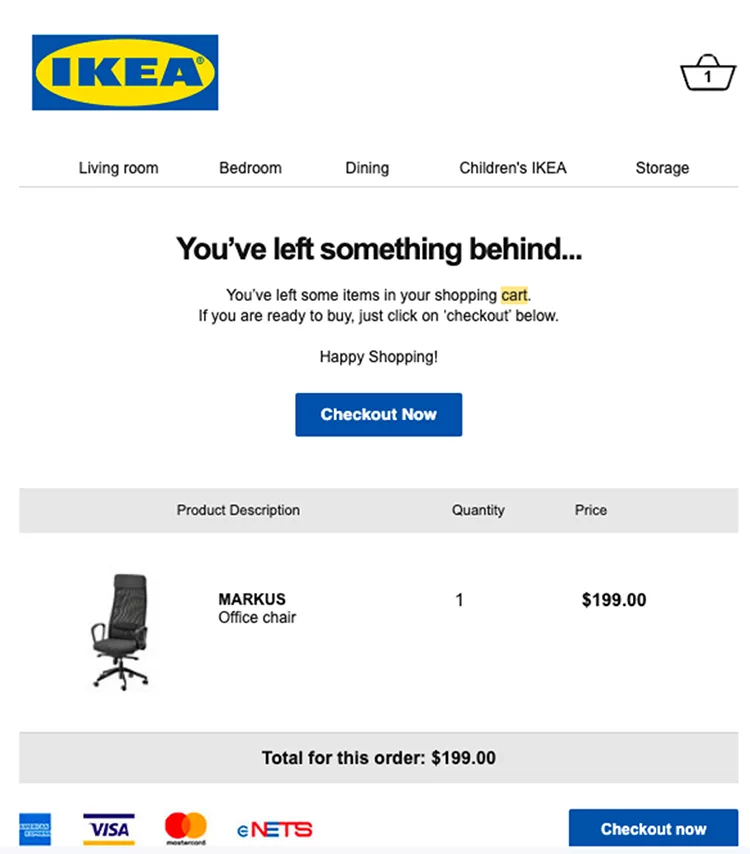
Or sending education emails with a soft pitch for your existing product lineup:

And unless you’re a web designer and developer, you’ll want to use software to make this process easy.
A tool like ClickFunnels 2.0 is a GREAT way to save a ton of time (and money) while establishing your online presence and building your email list.
With it, you can have your email subscription forms up and running in as little as an hour.
If you’re not already using it, you can click here to start your free 14-day trial and begin creating your email subscription forms and landing pages now.
When you do, you’ll be able to choose from a wide variety of funnel templates:
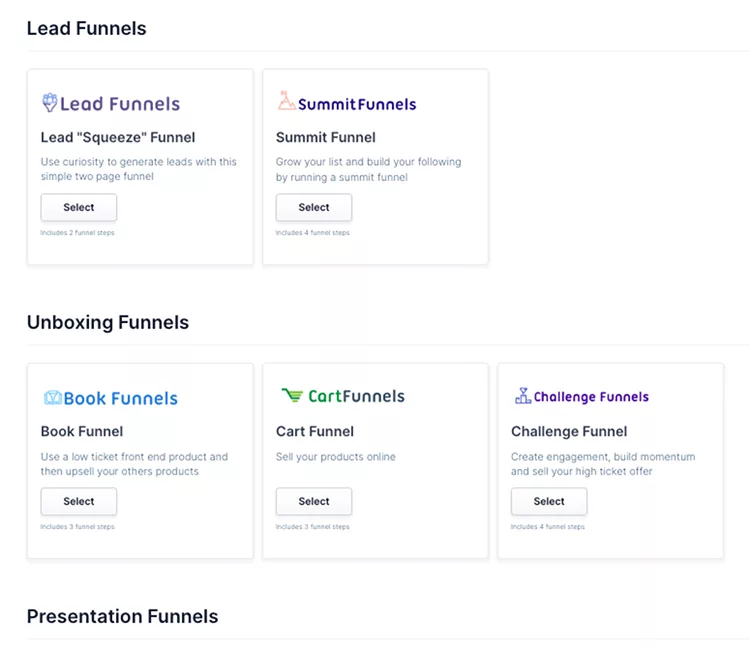
For collecting emails, you can use a basic squeeze page and thank you page template:
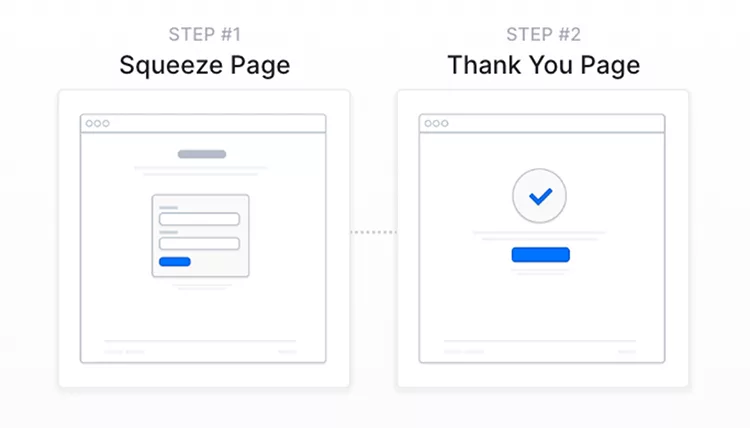
Try ClickFunnels FREE Today!
For instance, let’s say you operate a canine retreat.
If you wanted to entice people to subscribe to your email list, you could offer a full day free trial so they get to experience the retreat before becoming a paid client.
Here’s what your squeeze page funnel would look like:
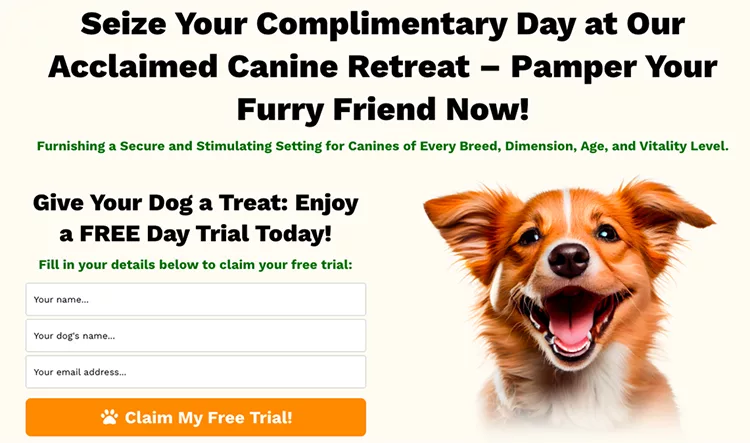
Then, after someone enters their email and subscribes, they’ll be taken to your thank you page:
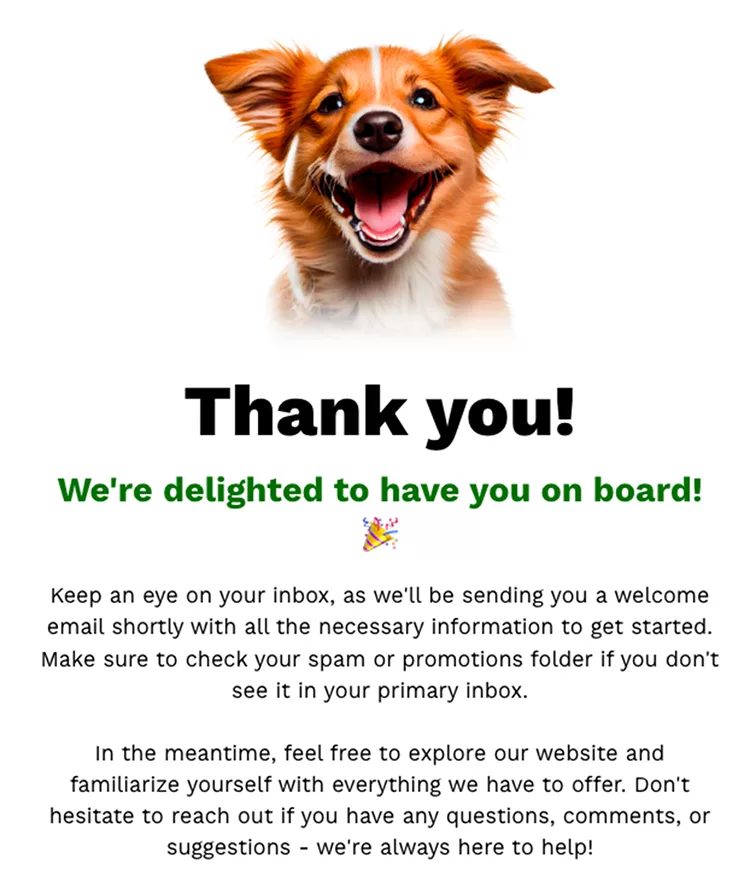
Then, once you’ve put together your squeeze funnel, landing page, and thank you page using the professionally designed templates inside of ClickFunnels 2.0, you can begin sharing them.
You can use a QR code inside your physical business that people can scan and be taken directly to your signup page, or share it across your social media profiles.
To get started, click here to begin your free 14-day ClickFunnels 2.0 trial now.
Hosting Webinars
Hosting webinars is one of THE most effective ways to generate a ton of buzz for your business.
When used for product launches, event hostings, seasonal promotions, and to announce the launch of your new business, they can help drive new customers through your doors.
And if you aren’t familiar, a webinar is an online presentation where you’re showcasing what you’re doing, why it matters to people, and what steps they can take next to get involved.
They work so well because they offer value first and build trust as you’re connecting with your audience.
They also help you drive more subscribers onto your email list by having people register for your webinar in advance of it going live.
At first glance, hosting a webinar can seem like a daunting task.
But when you start digging deeper into the process, you start to realize that it doesn’t have to be stressful and overwhelming.
To get started hosting your first webinar, there’s really only a few things you need.
The first is a landing page where you can promote your free webinar and start collecting email addresses.
The second is a registration page where people can input their information and create a calendar invite for the date and time of the event.
Finally, you’ll need a series of followup emails that help keep people engaged and remind them of the upcoming date and time of the event.
With these 3 things in place, you can have your first webinar funnel set up in a few short hours.
Here’s how to do it.
The first step is planning out how you’re going to get attention and generate buzz for the webinar.
The most common strategy used here is social media marketing.
Here’s an example of an ad from a recent MindValley webinar announcement:
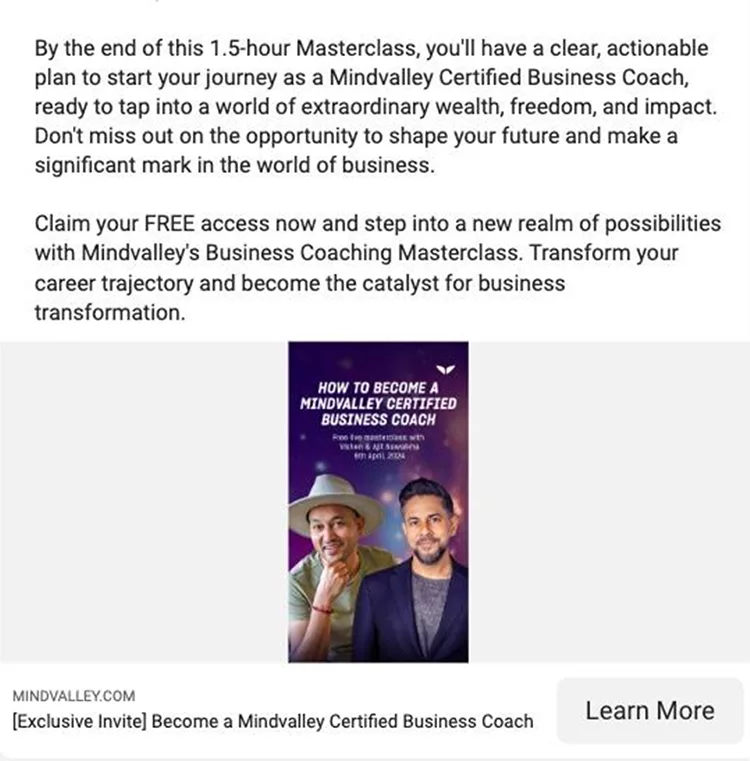
While ads like the one you see above are incredibly effective for driving new visitors to your registration page, you can also email your existing list — if you’ve already started building one.
You can use a series of automated emails to let people know what’s coming, how to get involved when it’s going to happen, and what’s in it for them when they register.
Here’s an example of an automated sequence that’s sent out for the MindValley webinar:

Then, when you’ve gotten people’s attention and shown them why they should register, they can visit the landing page you’ve created in ClickFunnels.
Here’s an example landing page from the MindValley campaign:
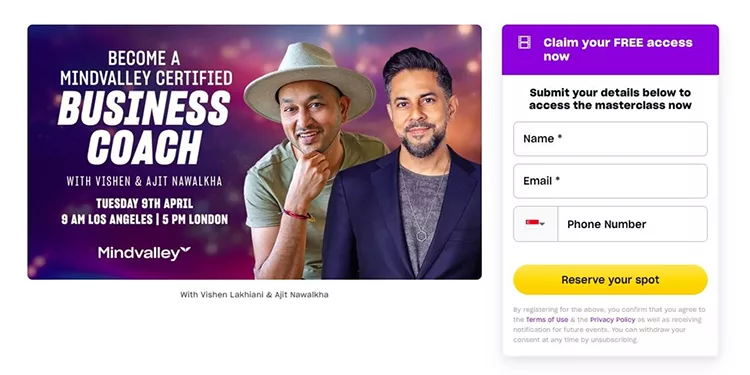
When people enter their information and register, they’ll get added to an automated follow-up sequence that keeps them interested and engaged leading up to the event.
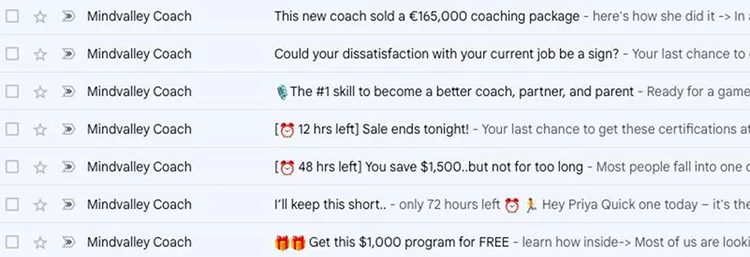
And all this can be done within a few mouse clicks when you’re using ClickFunnels 2.0.
To get started building your webinar funnel, click here to begin your free 14-day trial now.
When you’re in ClickFunnels, you can choose the webinar flow template to begin.
It will contain 3 key pages:

The pre-built funnel template will host your registration page, the confirmation page that includes details on the event, and the watch page where people will be able to see your presentation.
Then you can edit the pages using our built-in drag-and-drop editor:
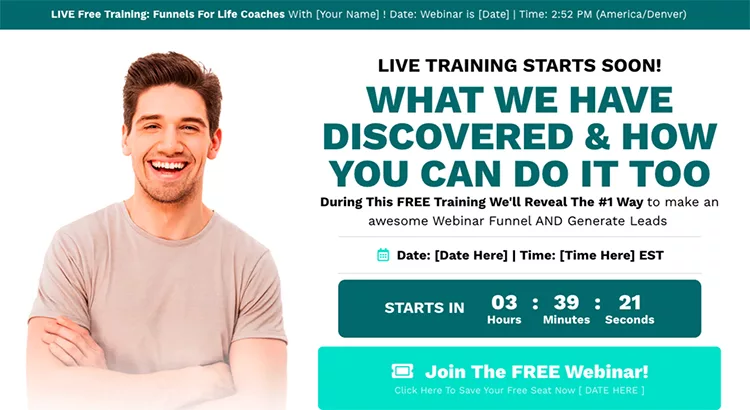
Once you have the pages edited so they perfectly match your brand and the goals of your webinar, you can begin putting together the automated sequence of emails that your registrants will receive.
To do this, you can use the built-in ClickFunnels Workflows:
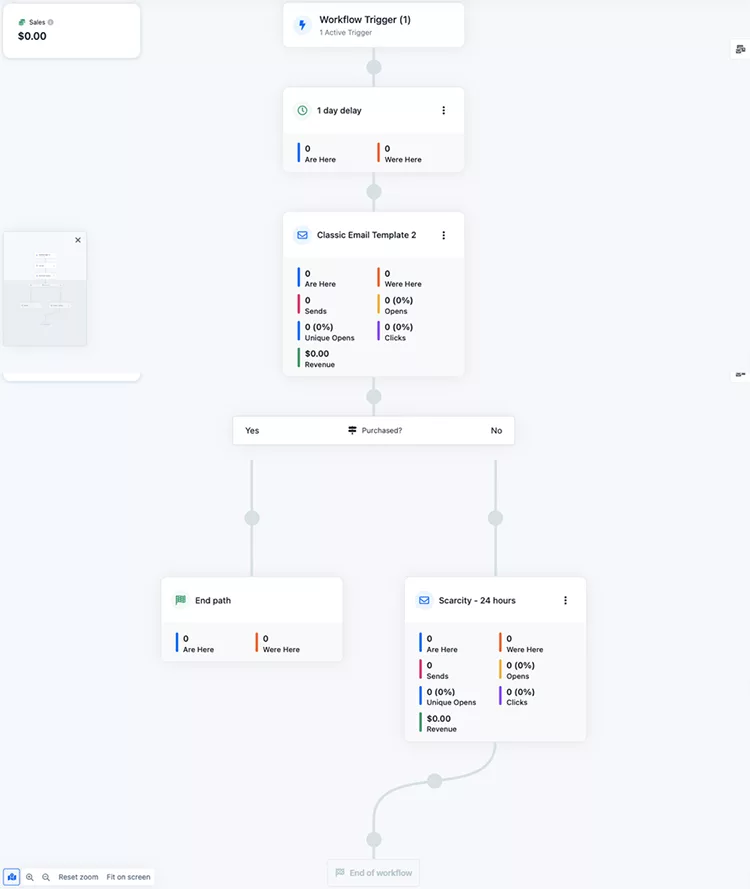
And, like our landing page designer, you can use drag-and-drop editors to pick and choose when and how you want the emails sent using built-in triggers.
You can also fully edit each of the emails so they match your brand’s design:
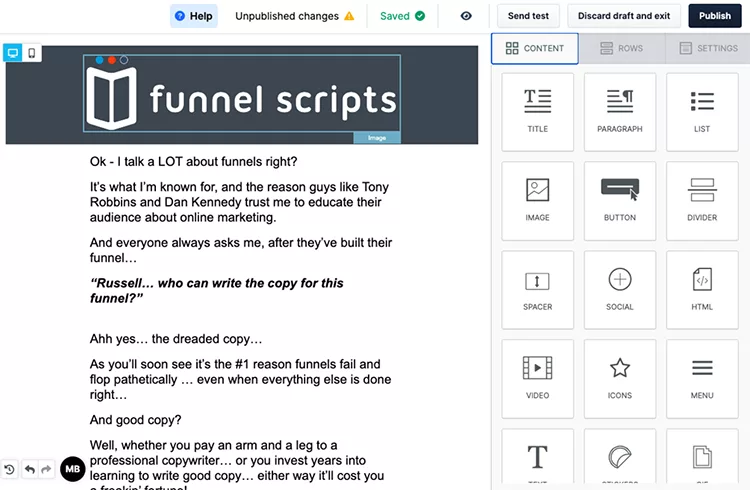
After you’ve put together your webinar funnel pages and your automated email sequence, you’re ready to start promoting your event on social media, your blog, email list, or any other traffic source that you’re currently marketing to.
This brings us to the next strategy that works amazingly well for small businesses.
Try ClickFunnels FREE Today!
Using Content Marketing
If you want to drive free, organic traffic to your business without spending money on ads then you need to start using content marketing.
The content you use to promote your business can be anything from written blog posts and emails, to video content on platforms like YouTube (or even your own blog), podcasts, you name it.
If people are actively searching for anything related to your products and services, you should work to capture their mind space with your content so you can engage with them later — in an effort to convert them into a new customer for your business.
For example, if you search for questions related to dog groom, here’s what you’ll see:
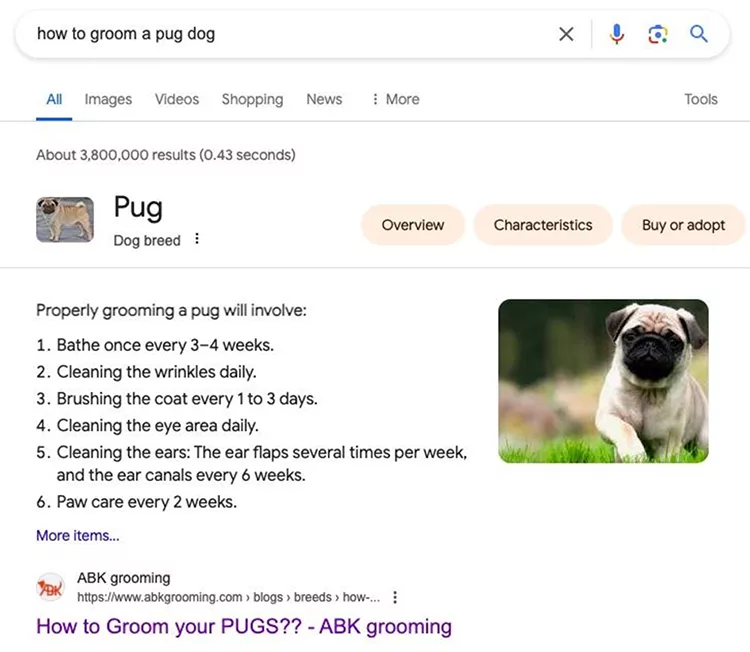
When you perform the search, Google presents you with a list of blogs.
The top blog that’s featured has a list of different grooming techniques for pugs.
If you click that link, you’ll be taken to the blog post where you can learn more:
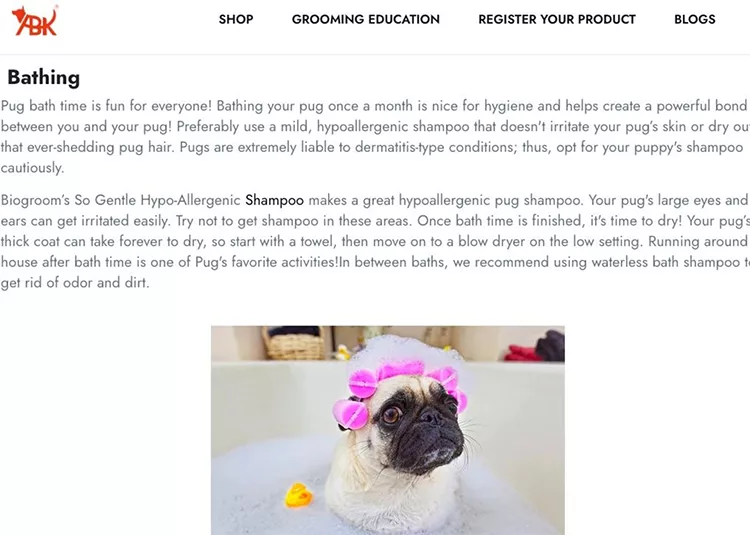
Then, you’ll be introduced to different grooming products you may be able to use:
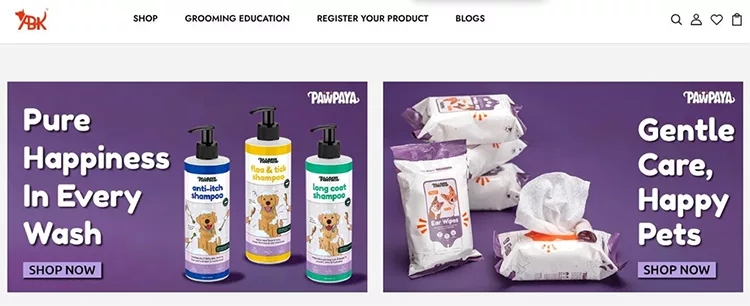
This strategy doesn’t just work for written content, either.
Since Google owns YouTube, you can capitalize on this partnership by creating videos and getting them to rank in Google’s search results page.
Take a look below to see what we mean:

Because Google owns YouTube, YouTube videos are given favor in the search results pages.
That means you can create written content on your blog and then create a video using the same keywords you targeted with your blog post and show up twice.
If you own a dog grooming business, especially if you focus on grooming pugs, this gives you a massive opportunity to capture the attention of people who are actively searching for solutions to a problem.
As a general rule of thumb, search engine traffic tends to be some of the highest-converting traffic you can drive to your business — so definitely do not sleep on it.
With content marketing, you can get in front of them.
To get started with this strategy, though, and avoid making it too complicated, there’s a bit of research that you’ll want to do.
For instance, you want to take a second to think about the questions your customers ask you.
If your customers are asking you specific questions, chances are high that they’ve also entered those same questions into Google while looking for answers.
Then, you’ll want to spend a bit of time researching your competitors.
You can take a look at their blogs to see which types of content they’re creating, and what topics they’re covering, and then put together a plan for your own content based on what you find.
Finally, you can take a look at forums like Reddit to see what questions people are typically asking.
With forums, you can get involved and answer their questions directly or you can take those questions and turn your answers into content for your blog.
When you get this strategy right, you’ll begin developing a consistent stream of new traffic to your business website — which can be converted into new customers in your business.
Tapping Into Referral Marketing
Once you have the foundations laid, you can start relying on your new customers to bring more business to you.
Tapping into referral marketing is a GREAT way to get more traction and grow your business.
The key with this strategy, though, is making sure your existing customers have a way to refer your business to other people — AND that you’re doing what you can to turn them into loyal advocates.
With referral marketing, whenever a customer is in a conversation with someone they know and they ask about their experience with a business… or ask for a recommendation to a business similar to yours, your customer can let them know about their experience with you.
If it was a good experience, chances are high that the person they recommended you to will check you out and potentially become a new customer.
This is, essentially, free marketing.
And when you really want to level up your referral marketing game, you can even incentivize people to recommend your business to others.
Check out how The Tonic does it:

Whenever someone recommends The Tonic to their friends or colleagues, their referrals are tracked.
After a certain number of referrals have been sent over, they’ll be able to start receiving special bonuses.
This can be one of THE most effective marketing strategies you’ll use in your business because recommendations like this come with an innate, built-in trust and social proof.
It also lets you acquire customers without spending any more money.
Those are both complete game changers for a small business.
Now, to get started using this strategy, you need to implement a couple incentives.
You want one available for the person making the recommendation — and another incentive available for the person receiving the recommendation.
Then, once you have both incentives in mind, you can start building a page that makes it easy for people to recommend your business.
This can be done in ClickFunnels 2.0 — you can get started free with a 14-day trial by clicking here.
After you’ve built the page, you can begin to promote it.
To help you get started, here’s another example of a great referral landing page:
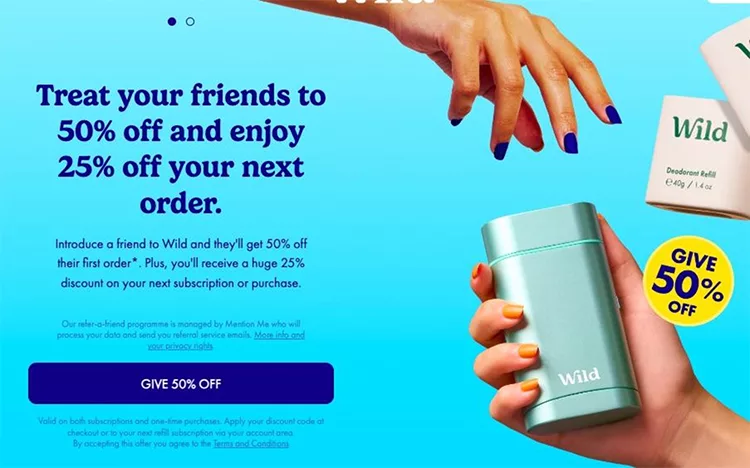
You’ll also want to include your referral program marketing materials inside of the packaging you used to sell your products:
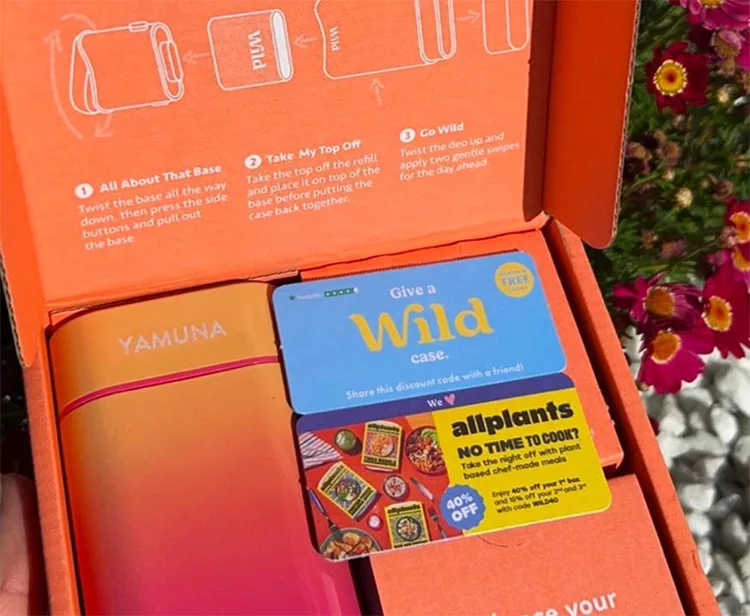
Then, remind your customers that the program exists with periodic emails:
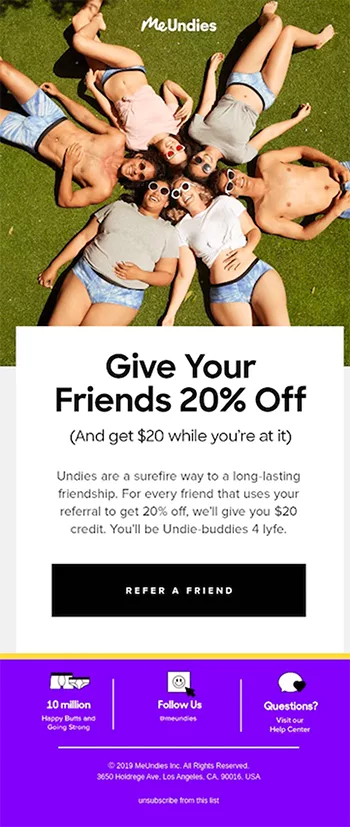
Once you have this in place, remember, a happy customer will refer other happy customers.
That means you want to make sure you’re taking care of people who come into your business — so you can turn your existing customers into long-term, loyal advocates.
Hanging Out With Your Customers
Right now, there are communities online where your future customers are already hanging out.
When you get into those communities, you can start raising awareness for your business and building credibility with those future customers.
And all you have to do is get involved in the conversation that’s already happening.
For instance, you can post valuable content related to your industry, products, and services.
Or you can provide key insights and participate in the discussion that happens after you share them.
To give you an example, check out this post:
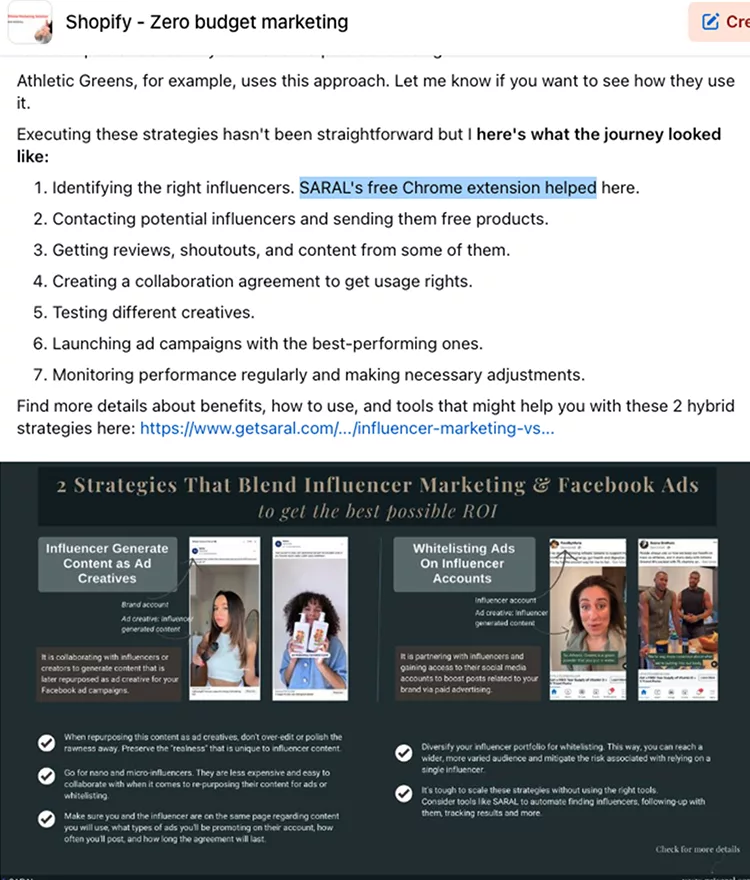
When you look closely at it, the one thing you’ll notice is that it isn’t spammy or promotional.
This is the biggest mistake most small business owners make when they’re trying to use this strategy.
They’ll jump into communities and start posting ads for the products or services.
Then wonder why they got kicked out.
Don’t do that.
Instead, make sure you’re actually adding value and joining in on the conversation.
In the example above, you’ll notice that it’s a “Shopify Zero Marketing Budget” community.
It’s a place where eCommerce business owners are hanging out which are the perfect target audience for a tool that helps people do influencer marketing.
Rather than posting an ad about the tool, the business owner created a piece of content that lends insights into how to get the most out of influencer marketing.
Then, if people are interested, they’ll start researching the tool’s creator — and potentially buying it.
Here’s another example of someone selling their services… without selling:
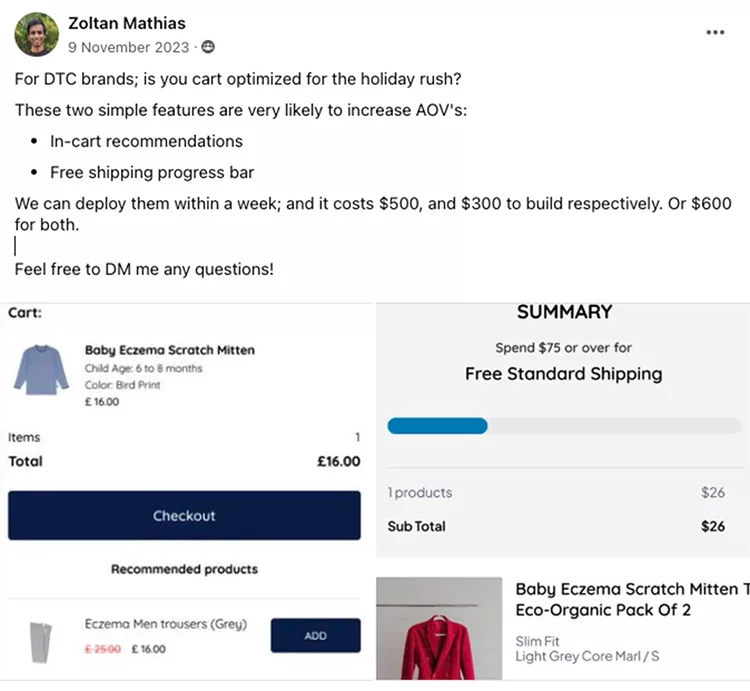
In this post, the creator is providing some value and encouraging people to connect.
These people first become leads and then become customers.
The key to getting this right is making sure you’re identifying the right communities.
Here’s a quick rundown on how to find some:
| Forum Type | Platform Examples |
|---|---|
| Tech & Startups | Reddit (r/startups, r/Entrepreneur), Hacker News |
| Health & Wellness | Reddit (r/fitness, r/nutrition), Facebook Groups |
| Beauty & Fashion | Reddit (r/beauty, r/makeupaddiction), Facebook Groups |
| Gaming | Reddit (r/gaming, r/pcgaming), Discord Servers |
| Professional & Industry Specific | LinkedIn Groups, Industry-specific forums (e.g., Stack Overflow for developers) |
Then, once you’ve identified the communities you want to join, you’ll need to come up with ideas for content that will add to the conversation.
To make it easy, here are a few quick examples:
- Tech & Startups: “5 Common Pitfalls When Launching Your Tech Startup and How to Avoid Them – would love to hear your thoughts and any lessons learned you might have!”
- Health & Wellness: “Compiled a list of nutrient-dense recipes for busy professionals. Tried incorporating [Your Product] in a few and the results were surprising. Feedback?”
- Beauty & Fashion: “Exploring sustainable fashion trends for 2023. Recently tried out a new eco-friendly fabric for our upcoming line – thoughts on sustainability in fashion?”
- Gaming: “Developed a tool that helps optimize gaming setups for better performance. Tested it on [popular game], here’s what I found. Would love your input!”
Being Present on Google My Business
Remember earlier when we mentioned that your future customers are already searching for you?
If you’re a local business, that means they’re going to be seeing Google My Business listings for businesses just like yours.
If you aren’t already utilizing this free service, those future customers will end up with your competition.
And if you aren’t familiar with Google My Business, it’s a free tool that lets you manage how your business information appears across Google, including Google Search and Google Maps.
By verifying and editing your information, you can make it easier for customers to find you.
Check out our Google My Business listing below:
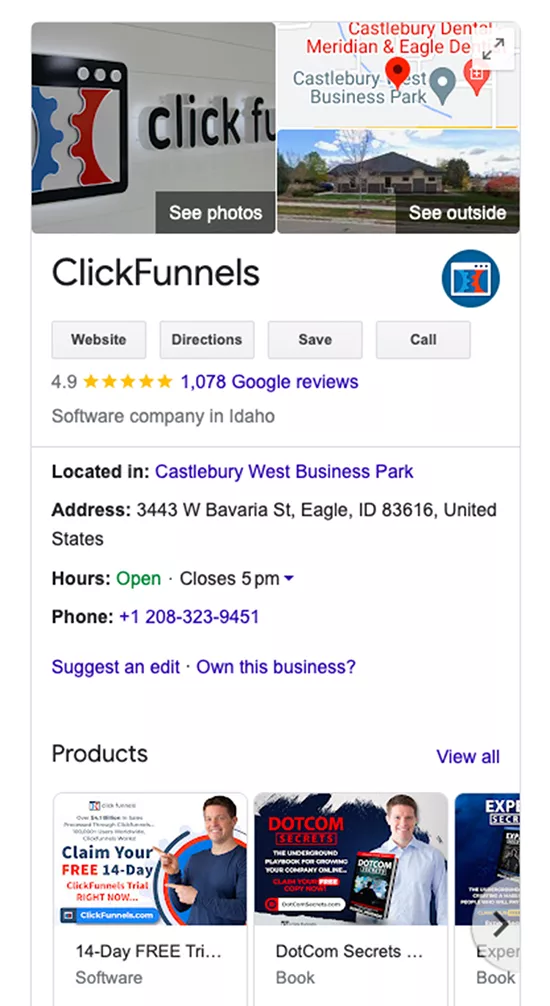
Then, when one of your future customers is searching for businesses like yours, your business will appear in the search results — making it incredibly easy for them to find you.
For instance, check out what shows up when you search for a florist in NYC:
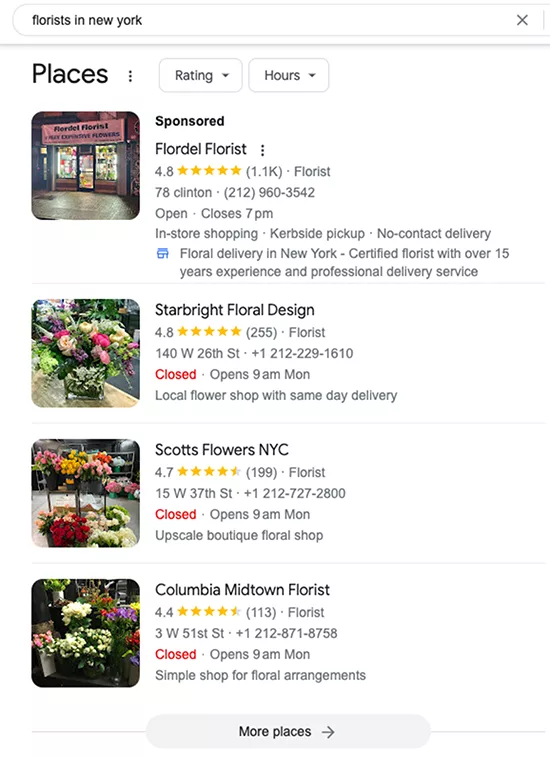
When someone searches, they’ll get to see reviews and ratings for social proof.
To get started with this strategy, you’ll need to create your profile at https://google.com/business.
You’ll need to make sure you fill out all of the details — contact details, reviews, photos, location, what you serve, pricing, etc.
You also want to make sure you include photos to showcase your products and services.
For example, here’s a great restaurant listing:

Here’s another example from a local landscaping company:
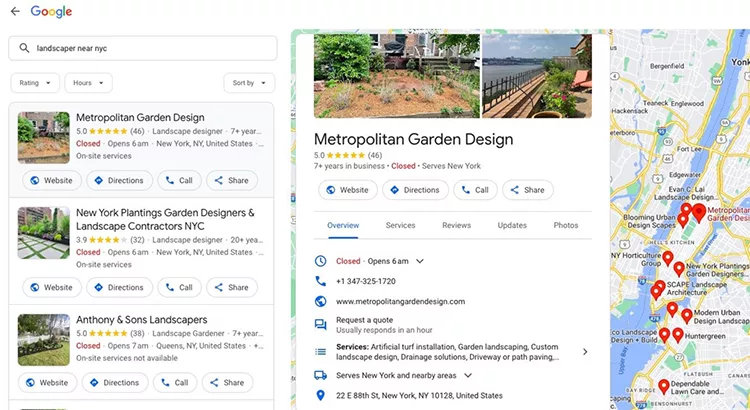
Then, to help boost your listing, make sure you’re responding to ALL reviews:
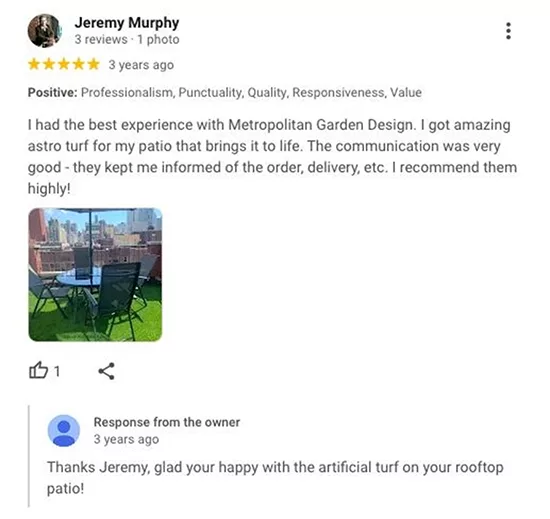
…even if they’re bad:
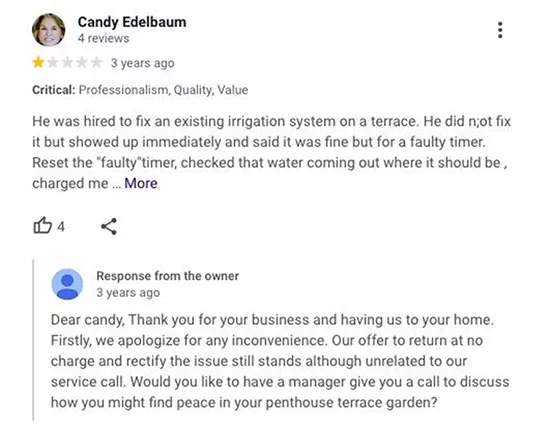
Implementing Loyalty Programs
Another great strategy you can use to grow your small business is a loyalty program.
Since it’s often more costly to acquire a new customer than it is to retain an existing one, offering loyalty programs to your existing customers can keep them coming back to your business in the future.
By offering incentives for repeat purchases, you get to ensure steady business growth.
Then, you get more word-of-mouth referrals since people are getting more bang for their buck with your active loyalty programs.
It’s a win-win situation.
And there are different types of loyalty programs you can run.
Stamp Cards: Offer a card where after a certain number of purchases (e.g., 9 coffees), the next one is free, like the example below:
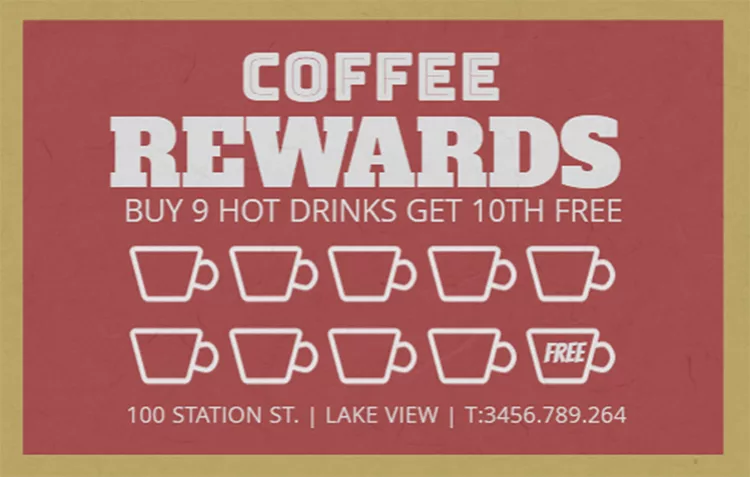
Points System: For every purchase, customers accumulate points. After accumulating a certain number, they can redeem them for a free item:
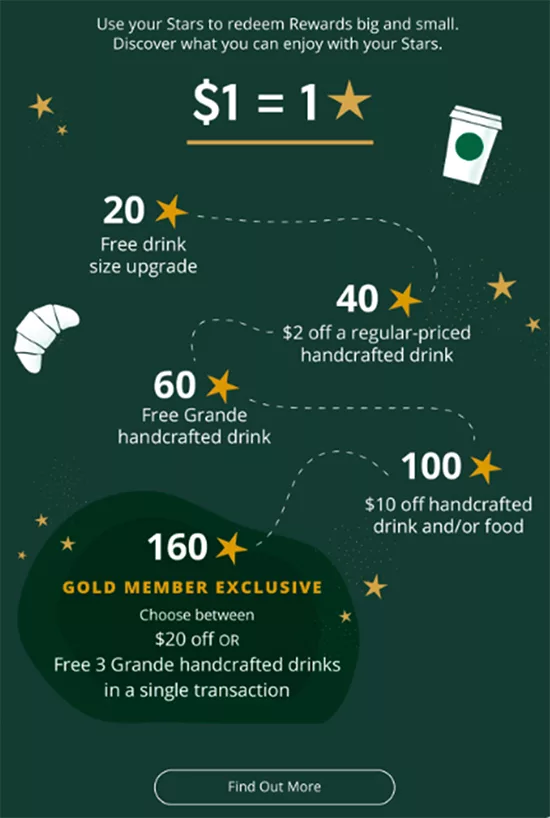
Subscription Model: Allow customers to pay a monthly fee for a daily brew. This guarantees regular visits and a steady income.
Exclusive Member Days: On specific days or hours, loyalty members can get additional points, special discounts, or unique offerings.
Skip-the-Line Privileges: Allow your most loyal customers the benefit of skipping the line during rush hours.
Early Access: Provide loyalty members with early access to new flavors, seasonal drinks, or limited-time offers.
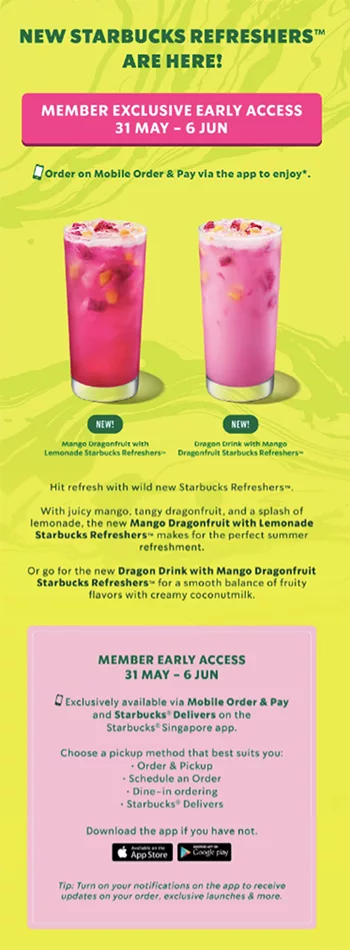
Special Member Events: Organize occasional events like tasting sessions, coffee brewing classes, or cafe nights exclusive for loyalty members.
Depending on the products and services you offer, get creative with the way you incentivize your long-term, loyal customers to keep coming back to your business.
When you combine your loyalty program with the other small business marketing strategies on this list, though, you can start to experience consistent growth year-over-year.
The key, though, is laying the right foundations.
To ensure long-term success, you want to make sure your future customers can find you online — and that you’re collecting their information so you can stay in touch with them.
If you don’t already have landing pages in place, you’ll want to give ClickFunnels 2.0 a try.
You can click here now to start your free 14-day trial.
Then implement each of the strategies in this guide, driving people to your brand new landing pages.
Try ClickFunnels FREE Today!
Thanks for reading 7 Small Business Marketing Ideas which appeared first on ClickFunnels.
If Click Funnels is of interest and you'd like more information, please do make contact or take a look in more detail here.
Credit: Original article published here.
